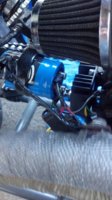motorbreath
XS650 Addict


Couldn't figure how to use video but heres one of it running
https://www.facebook.com/photo.php?...703026&type=2&theater¬if_t=video_processed
Im running hughs PMA, standard pamco ignition, and TC bros capacitor. 1981 xs650
This is the diagram i used but the other black blobs are inline fuses i added, any way here are my readings i have.
From the red wire on the regulator i got 14.82-14.89V
Regulator to Capacitor i have 14.33-14.78V
Capacitor to B position on Key switch i have roughly 14.83V
L position on key switch to my kill switch i have 14.55V
Now from the other on side of the kill switch to coil i have an obscure number collection ranging from anywhere such as 3V-12V
Thanks

 but i was reading that people leave the battery and capacitor on together, and i used the multimeter on the battery and when i Gave it gas and it was reading 12.8v - 14.3v so the battery is charging which is good,
but i was reading that people leave the battery and capacitor on together, and i used the multimeter on the battery and when i Gave it gas and it was reading 12.8v - 14.3v so the battery is charging which is good,  , i feel like I'm on the right track thanks to fellow members,
, i feel like I'm on the right track thanks to fellow members,